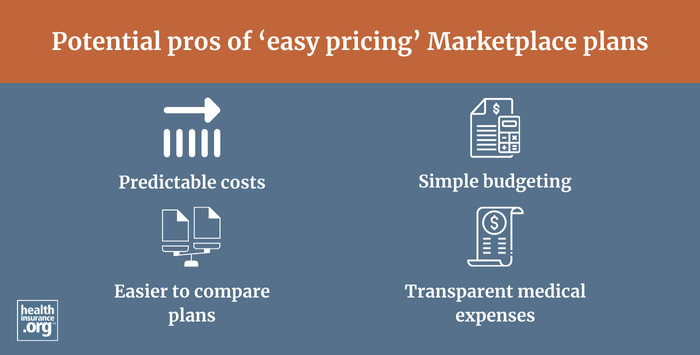
What is easy pricing?
Easy pricing is the name that the federally run health insurance Marketplace (HealthCare.gov) uses for health insurance plans standardized within their category (metal level). These plans debuted on HealthCare.gov as of the 2023 plan year, and continue to be available for 2025. Easy pricing plans have the same deductibles, out-of-pocket limits, copays, and coinsurance for a variety of services, making it easier to compare apples to apples when shopping for coverage.
Easy pricing plans must be offered by every insurer that offers plans through HealthCare.gov. Insurers are allowed to also offer non-standardized plans, but they must offer standardized (easy pricing) plans at every metal level, for every product type (HMO, PPO, etc.), and in every service area where they offer non-standardized plans.
HealthCare.gov previously offered standardized plans (known as Simple Choice plans) in 2017 and 2018, but it was optional for insurers to offer those plans and they were discontinued as of 2019.
How are costs standardized on easy pricing plans?
The U.S. Department of Health and Human Services (HHS) sets the standardization parameters for easy pricing plans, and the specifics are updated annually. See the 2025 standardized plan details in Table 11 of this document.
As illustrated in that table, easy pricing plans have uniform deductibles, coinsurance, out-of-pocket limits, and copays for certain services. These vary by metal level, but are otherwise the same in nearly every state that uses HealthCare.gov.
(Note that the easy pricing plans in Delaware and Louisiana are slightly different, because those states have laws limiting specialty drug cost-sharing to no more than $150. And Oregon has its own standardized plan rules. So, while the easy pricing label is used in Oregon just as it is in other states that use HealthCare.gov, the specific coverage details are different in Oregon.)
How can I find easy pricing plans?
If you’re shopping on HealthCare.gov, these standardized plans will say “easy pricing” beneath the plan name, along with a little image of a green circle with a white tag inside it.
If you just use the default plan sorting feature, it will show all available plans, ordered from lowest to highest premium. The easy pricing plans will be scattered throughout the results. But you can also filter the results to show only easy pricing plans if that’s your preference.
To do this, you’ll use the green “add filters” button. That will open a box with three columns of information. At the bottom of the left column, you’ll see check boxes for each available metal level (Bronze, Silver, Gold, and if available, Platinum). If you check any or all of these boxes, an additional box will appear that says “with easy pricing.”
You’ll check that box (for any or all metal levels) and then use the green “apply filters” button. The system will then display only easy pricing plans, and you can use additional filters to further narrow the options if you have other parameters in mind.
Enhanced direct enrollment entities are required to have similar differential displays for these standardized plans, so you’ll find similar easy pricing filters on those websites as well.
And if you’re working with a broker or Navigator, they’ll be able to help you understand how the easy pricing plans compare with each other and with the other available plan options. There’s no charge to use a broker or Navigator, and it’s in your best interest to get assistance with the plan selection and enrollment process.
Should I enroll in an easy pricing plan?
There is no right or wrong answer here. The easy pricing plans are designed for easier comparison shopping, and with the exception of Bronze plans, they all cover certain services with copays (instead of applying those services to the deductible). There are also easy pricing Silver plans at each cost-sharing reduction level, for people who are eligible for those plans. But the easy pricing plans may or may not fit your specific needs and budget.
Do states that operate their own exchanges have easy pricing plans?
Although they don’t use the term "easy pricing," states that run their own exchanges can offer standardized plans, and several do:
- California (All plans are standardized.)
- Colorado (Standardized “Colorado Option” plans debuted for 2023.)
- Connecticut (The word “Standard” will be in the plan name.)
- Washington, DC (The plans cover Type 2 diabetes treatment with no cost-sharing.)
- Maine (Clear Choice plans)
- Maryland (Value Plans; See standardized plan designs for 2025)
- Massachusetts (The word “Standard” will be in the plan name.)
- New York (Standardized plans have “ST” in the plan name, non-standardized have “NS”.)
- Vermont (Here’s a comparison of the standardized and non-standardized plans for 2025.)
- Washington ("Cascade Care" See standardized plan designs for 2025.)


